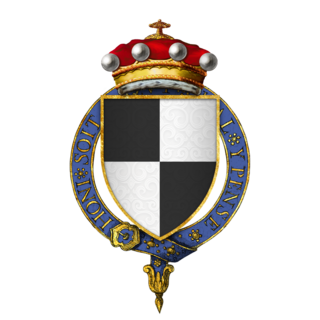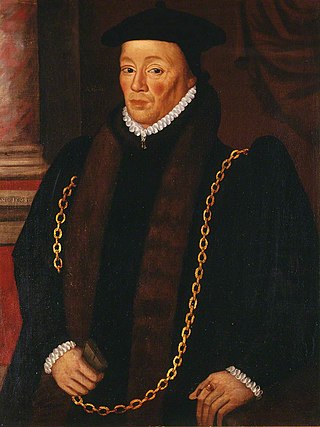
Baron Greystoke (or Greystock) is a title that has been created twice in the Peerage of England. It was first created when John de Greystok was summoned to Parliament in 1295.

Baron Greystoke (or Greystock) is a title that has been created twice in the Peerage of England. It was first created when John de Greystok was summoned to Parliament in 1295.
John son of William de Greystok was summoned to Parliament by Edward I of England. [1] In 1296 John's cousin Gilbert Fitzwilliam, descendant of John's aunt Joan de Graystock, died, and Gilbert's younger brother and heir, Ralph Fitzwilliam, did homage for Gilbert's lands and entered thereon. [2] In August 1297 John obtained licence to enfeoff Ralph Fitzwilliam with the manor and whole Barony of Greystok, [3] [4] and with other manors and advowsons including his part of Morpeth, [5] in fee simple, upon condition that Ralph should found a college in the church at Greystoke. [6] Ralph, whose family were lords of Grimthorpe in the soke of Pocklington, Yorkshire, was then preparing to go abroad in the King's service, and in April 1298 he in return demised the feudal barony of Greystok and other manors for life to John (who thenceforward held them from Ralph as Ralph's sub-tenant), with reversion to Ralph. [7] In 1300 Ralph made some provision for John's brother William Greystok. [8]
Following the death of John de Greystok in 1306, [9] the Barony of Greystok reverted to Ralph FitzWilliam in fulfilment of the arrangements made eight years previously, [10] and Ralph, who was summoned to Parliament from 1295 to 1315, [11] made homage and received royal assent to enter upon the barony in October 1306. [12] In 1315 he founded a chantry at the conventual church of Tynemouth, under the aegis and seal of St Albans Abbey, for the soul of John de Greystok "quondam baronis de Graistok cognati sui" (i.e., "sometime baron of Graystok, his kinsman"), and for his own soul, the abbey's award to him describing Ralph Fitzwilliam as Baro de Graystok and bearing his seal. [13]
Ralph Fitzwilliam (who married Marjory de Bolebec) died in 1316, and their son Robert FitzRalph (who married Elizabeth, daughter of Robert Nevill of Scotton, Lincolnshire) died in the following year, leaving as his heir his son Ralph FitzRobert. [14] This younger Ralph received Parliamentary summons in the name of Ralph de Greystock, and so became the first of the Fitzwilliam (Lords of Grymthorp) lineage to carry the Greystock name and title (1321). The arms of Greystock as Barruly argent and azure, three chaplets of roses gules were originally those of Grymthorp, and as such were borne by Ralph Fitzwilliam at the Siege of Caerlaverock, [15] and serve to identify his tomb effigy rescued from Neasham Priory, [16] but were retained and quartered with the former Greystock arms by his successors. [17] [18]
The barony went into abeyance in 1569, after it had passed into the Dacre family in 1487 through the marriage of Thomas Dacre, 2nd Baron Dacre to Elizabeth de Greystoke, 6th Baroness Greystoke. [19]

John de Warenne, 7th Earl of Surrey, was the last Warenne earl of Surrey.

Nicholas de Crioll, of a family seated in Kent, was Constable of Dover Castle and Keeper of the Coast during the early 1260s. His kinsman Bertram de Criol had distinguished himself in these offices during the preceding 20 years and both were near predecessors of the eminent Warden of the Cinque Ports, Stephen de Pencester.

Fulk FitzWarin, variant spellings, the third, was a prominent representative of a marcher family associated especially with estates in Shropshire and at Alveston in Gloucestershire. In young life, early in the reign of King John (1199–1216), he won notoriety as the outlawed leader of a roving force striving to recover his familial right to Whittington Castle in Shropshire, which John had granted away to a Welsh claimant. Progressively rehabilitated, and enjoying his lordship, he endured further setbacks in 1215–1217.

Leiston Abbey outside the town of Leiston, Suffolk, England, was a religious house of Canons Regular following the Premonstratensian rule, dedicated to St Mary. Founded in c. 1183 by Ranulf de Glanville, Chief Justiciar to King Henry II (1180-1189), it was originally built on a marshland isle near the sea, and was called "St Mary de Insula". Around 1363 the abbey suffered so much from flooding that a new site was chosen and it was rebuilt further inland for its patron, Robert de Ufford, 1st Earl of Suffolk (1298-1369). However, there was a great fire in c. 1379 and further rebuilding was necessary.

Thomas Hoo, was an English landowner, courtier, soldier, administrator and diplomat who was created a Knight of the Garter in 1446 and Baron Hoo and Hastings in 1448 but left no son to inherit his title.

Thomas Dacre, 2nd Baron Dacre of Gilsland, KG was the son of Humphrey Dacre, 1st Baron Dacre of Gilsland and Mabel Parr, great-aunt of queen consort Catherine Parr, the sixth and final wife of King Henry VIII of England. His mother was the daughter of Sir Thomas Parr of Kendal by his wife, Alice Tunstall.

Thomas Dacre, 6th Baron Dacre of Gilsland was a medieval English nobleman.

Sir William Garrard (1518–1571), also Garrett, Gerrarde, etc., was a Tudor magnate of London, a merchant citizen in the Worshipful Company of Haberdashers, who became alderman, Sheriff (1552–1553) and Lord Mayor of London (1555–1556) and was returned as an MP for the City of London. He was a senior founding officer of the Company of Merchant Adventurers to New Lands in 1554/55, having been involved in its enterprises since the beginnings in King Edward VI's time, and for the last decade of his life was one of its permanent governors. He worked hard and invested largely to expand English overseas trade not only to Russia and the Levant but also to the Barbary Coast and to West Africa and Guinea.

John Tuchet, 6th Baron Audley, 3rd Baron Tuchet was an English politician.
Campsey Priory,, was a religious house of Augustinian canonesses at Campsea Ashe, Suffolk, about 1.5 miles (2.5 km) south east of Wickham Market. It was founded shortly before 1195 on behalf of two of his sisters by Theobald de Valoines, who, with his wife Avice, had previously founded Hickling Priory in Norfolk for male canons in 1185. Both houses were suppressed in 1536.
William Dacre, 7th Baron Greystock, later 3rd Baron Dacre of Gilsland was an English peer, a Cumberland landowner, and the holder of important offices under the Crown, including many years' service as Warden of the West Marches.

Ralph Fitzwilliam, or Ralph, son of William de Grimthorpe, Lord of Greystoke, was a feudal baron with extensive landholdings in the North of England, representative of a manorial lordship seated where Grimthorpe Hill rises to commanding views a mile to the north of Pocklington in the Yorkshire Wolds. He gave sustained military service and leadership through the Scottish and Welsh campaigns of Edward I and was summoned to parliament from 1295 to 1315. His marriage in c. 1282 brought him other manors including Morpeth in Northumberland and its appurtenances. In 1297 he was enfeoffed as tenant-in-chief of the entire barony of Greystoke, seated at Greystoke in Cumberland but with Yorkshire estates, through his matrilineal Greystok descent. He entered upon these in his own right in 1306. Having served in the retinue of Aymer de Valence, during the first decade of Edward II's reign he remained dependable as a military leader and royal lieutenant in the defence administration of the northern counties and Scottish marches. His descendants adopted the Greystoke name, and their inheritance continued in the male line until the end of the 15th century.

William FitzHugh, 4th Baron FitzHugh was an English nobleman and Member of Parliament.
Sir Nicholas Haute, of Wadden Hall (Wadenhall) in Petham and Waltham, with manors extending into Lower Hardres, Elmsted and Bishopsbourne, in the county of Kent, was an English knight, landowner and politician.
John de Echingham S.T.D. was an English medieval Chancellor of the University of Oxford, who held that dignity for three consecutive years.

Ralph de Greystoke, 1st Baron Greystoke, was an English peer and landowner.
John Darras (c.1355–1408) was an English soldier, politician and landowner, who fought in the Hundred Years' War and against the Glyndŵr Rising. A client of the FitzAlan Earls of Arundel, he served them in war and peace, helping consolidate their domination of his native county of Shropshire. He represented Shropshire twice in the House of Commons of England. He died by his own hand.

Ralph Greystoke, 5th Baron Greystoke was a member of the English nobility in the early 15th century, and a protagonist during the Wars of the Roses in the north. By his marriage to Elizabeth, daughter of William, Lord FitzHugh he formalized the long-standing alliance that had existed between the two families for some time.

Baron St Maur was a barony created by writ in 1314 for the soldier Nicholas de St Maur, of Rode in Somerset.

Sir Thomas de Felton was an English landowner, military knight, envoy and administrator. He fought at the Battle of Crécy in 1346, and the Capture of Calais in 1347. He was also at the Battle of Poitiers in 1356. A recurrent figure in the Chronicles of Jean Froissart, he was a signatory to the Treaty of Brétigny in 1360. In 1362 he was appointed Seneschal of Aquitaine. He accompanied Edward the Black Prince on his Spanish campaign. He was taken prisoner by Henry of Trastámara's forces in 1367. In 1372 he was appointed joint-governor of Aquitaine and seneschal of Bordeaux. He caused Guillaume de Pommiers and his secretary to be beheaded for treason in 1377. He was invested a Knight of the Garter in 1381.